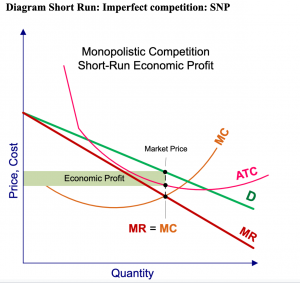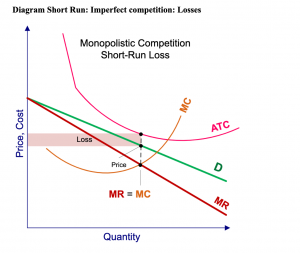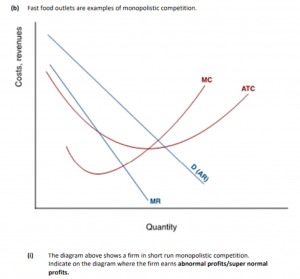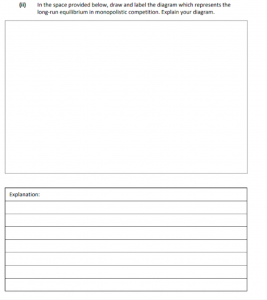Assumptions underlying Imperfect Competition
- There are many buyers in the industry: An individual buyer, by his/her own actions, can’t influence the market price of the goods
- There are many sellers in the industry: An individual seller can influence the quantity sold by the price it charges for its output.
- Product differentiation exists: The goods, supplied by the producer, are not homogenous but are close substitutes. Firms use branding to distinguish their products from one another
- Freedom of entry and exit: No barriers to entry exist within the industry. It is possible for firms to enter/leave the industry as they wish.
- Reasonable knowledge: Within the industry each firm has reasonable knowledge of profits made by other firms. Consumers have a reasonable knowledge of the prices being charged for different products.
In this video, compare the monopolistically competitive market structure to the previously covered structures (perfect competition and monopoly), and show the short-run and long-run outcomes for the firm.
Product Differentiation
The goods which are produced are close substitutes / similar goods / not identical goods. Product differentiation can be achieved by:
- Branding: Establishing different and distinctive brand names for the products. Nike, Addidas, Reebok
- Competitive Advertising: Creating differences in the products in the minds of consumers e.g. through packaging which clearly distinguishes one product from another Daz v. Surf / Kellogs Cornflakes
- Product innovation: Firms develop their product further (add value) so that it is better or more advanced than that of competitors.Lyons pyramid tea bags /Avonmore – super milk / Fairy detergent – anti bacterial agents
Advantages of Imperfect Competition to consumers
- Greater choice: Goods are not homogenous, but are close substitutes, therefore consumers have a greater choice of goods/services.
- Normal Profit: In the long-run consumers are not being exploited as the firm is earning normal profits.
- Lower prices: Competition between firms in the industry will help lower prices and make them more competitive for consumers.
- Innovative goods/services: Innovation is encouraged as firms will constantly strive to gain a competitive edge over their rivals, hence, consumers get the benefit of modern up-to-date goods/services.
Imperfect Competition is considered wasteful of economic resources
The firm at long run equilibrium is not producing where their average costs are at a minimum. The firm has overcapacity because equilibrium is not at the point of minimum cost.
Competitive Advertising: In order to keep their market share all firms take part in competitive advertising. This only pushes up costs for the consumer who ends up paying a high price for the product.
However, Advertising creates employment within the advertising industry and the firm itself through larger scales. Sponsorship, another form of advertising, ensures the survival of many sporting and cultural events. In Imperfectly Competitive Markets, product innovation is encouraged. Firms are always striving to introduce new or improved products to gain a competitive edge.
Exam Q:
Test your knowledge of Monopolistic competition




